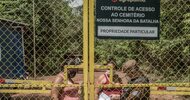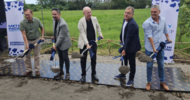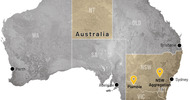PANAP | 15 October 2012
By G. Sape
Indigenous community leader Sumen Bin Gasan has a big burden on his shoulders. His neighbours, fellow Iban and Melanau indigenous groups from 132 houses and 4 longhouses along the mighty Rajang River in Sibu town in Sarawak, Malaysia, have designated him as leader in claiming back their native customary land from land grabbers. In the next few weeks, they will file a court case against an oil palm company and present evidences that the land rightfully belongs to them and that they have been tilling and taking care of it for generations.

Living in the same community for more than 100 years, generations of Sumen's family depend on their land for livelihood. Sumen is now 52 years old and just like his neighbours, they practice shifting cultivation - growing sago palm, fruit trees, paddy rice and vegetables. In between, their land and forests also provide them with traditional medicines and wild animals for hunting. The huge river that surrounds its communities used to supply the people with fish until its waters became too polluted with industrial and agricultural waste.
Under adat (native customary laws), the indigenous peoples of Sarawak have customary rights to land consisting of the right to cultivate the land, right to the produce of the forests, hunting and fishing rights, right to use the land for burial and ceremonial purposes, and rights of inheritance and transfer. The same customary law is also recognised under the Sarawak Land Code of 1958. Despite these, both private- and government-owned logging and oil palm companies have been continuously violating these rights. The Sarawak Dayak Iban Association (SADIA) that has been at the forefront of defending the rights of indigenous peoples recorded more than 400 court cases related to land grabbing of ancestral land. Sumen's case will be one of them.
In 2010, oil palm company Sarananas Sdn Berhad that is linked to Sarawak Chief Minister Abdul Taib Mahmud, was granted provisional lease (PL) by the Land and Survey Department for 2,500 hectares. Not yet happy with what they got, they still have a pending application for another 3,500 hectares. All in all, they want 6,000 hectares to clear for their palm oil plantation. The land, as most resources in Sarawak, is native customary land of indigenous communities that Sumen and his neighbours belong to. Just like many cases of land grabbing in Sarawak, government institutions tasked to safeguard the rights of indigenous peoples are also the same institutions that violate these rights through their powers to deliberate and decide on land conflict cases.
For the government of Sarawak, every piece of land should be utilised in the name of "development". Thus, reserved forests and lands should be logged and cleared and eventually, planted with oil palm. Indiscriminate logging of indigenous peoples' territories in the name of "development" has wiped out thousands of hectares of virgin rainforest. As a result, Malaysia's deforestation rate is increasing faster than anywhere else in the world.
Development in Sarawak, however, is one-sided. Sibu town, for example, has more millionaires per capita than any part of Sarawak, yet many rural communities, including Sumen's, remain without potable water or electricity. The massive wealth of the privileged few comes from logging and oil palm concessions at the cost of indigenous peoples' rights. Resources-wise, Sarawak, boasting of abundant liquefied natural gas and petroleum reserves, is the richest in Malaysia. Yet it has the poorest population, particularly among indigenous communities. Forty per cent of its population of 2.5 million are indigenous peoples, who should have control over Sarawak's rich productive resources by virtue of their native customary rights. Yet they have no power to decide on Sarawak's development path.

Meanwhile, still in Sibu town not far from Sumen's community, 5,000 hectares of land belonging to indigenous peoples have just been cleared for oil palm plantations with sanction from the Sarawak government. Sixty-three year old community indigenous leader Bujang Anak Kunjan said that the land, which is now under the control of various companies, was his community's "reserve land for future generations" under their native customary law.
Bujang narrated that in the old days, the contested land used to be a virgin forest with wild animals and different varieties of trees. It was also their community's source of traditional medicines and burial ground. Unlike Sumen's community, which is organised and fought the entry of Sarananas, Bujang's community quietly accepted its fate. "Where do we go to complain when the government is the one taking over the land?" he asked. But Bujang is not giving up. He sought the help of other organised communities like Sumen's to be able to strategise and reach out to more than 100 Iban families who rightfully have native customary rights to the land but didn't put up a fight.

Indigenous peoples' organisations such as SADIA play a crucial role in defending the rights of indigenous groups to their native customary land. Both Sumen and Bujang belong to SADIA and have been involved in organising their communities to defend their rights and the remaining forests of Sarawak. Aside from raising awareness on their rights as indigenous peoples, they have started mapping their ancestral domain.
Using a GPS device (global positioning system) and documenting evidence such as old trees, houses and burial sites to prove that the land has belonged to them for generations, Sumen led his community in mapping their land. These maps together with other evidences are presented to the court to support their case. It is a tedious and long process. A legal case such as this might last for five to 15 years in Sarawak but so far, this is the only recourse that indigenous communities have. In some cases, indigenous peoples win their case and get compensation. Some lose. For Sumen's case, since the community presented its mapping and evidence to the court, Sarananas has started initiating a dialogue with the indigenous peoples, which they refused to entertain so far as the case is already in the court.
For Bujang's community, it is still a long way to go. At 63 and with the possibility that the case could last for many years, he is determined to organise his community and fight for their rights no matter how long it might take them to succeed.
_________
This article is part of a series of feature stories on land grabbing in selected countries in Asia, as part of an awareness-raising campaign on how land grabs worsen hunger, in commemoration of 'World Foodless Day' on October 16 by PAN AP and its partner organisations. (http://www.panap.net/wfd)













